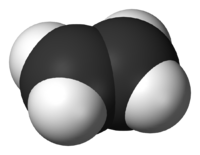
Photo from wikipedia
Carbon material is a promising electrocatalyst for the oxygen reduction reaction (ORR). Doping of heteroatoms, the most widely used modulating strategy, has attracted many efforts in the past decade. Despite… Click to show full abstract
Carbon material is a promising electrocatalyst for the oxygen reduction reaction (ORR). Doping of heteroatoms, the most widely used modulating strategy, has attracted many efforts in the past decade. Despite all this, the catalytic activity of heteroatoms‐modulated carbon is hard to compare to that of metal‐based electrocatalysts. Here, a “double‐catalysts” (Fe salt, H3BO3) strategy is presented to directionally fabricate porous structure of crystal graphene nanoribbons (GNs)/amorphous carbon doped by pyridinic NB pairs. The porous structure and GNs accelerate ion/mass and electron transport, respectively. The N percentage in pyridinic NB pairs accounts for ≈80% of all N species. The pyridinic NB pair drives the ORR via an almost 4e− transfer pathway with a half‐wave potential (0.812 V vs reversible hydrogen electrode (RHE)) and onset potential (0.876 V vs RHE) in the alkaline solution. The ORR catalytic performance of the as‐prepared carbon catalysts approximates commercial Pt/C and outperforms most prior carbon‐based catalysts. The assembled Zn–air battery exhibits a high peak power density of 94 mW cm−2. Density functional theory simulation reveals that the pyridinic NB pair possesses the highest catalytic activity among all the potential configurations, due to the highest charge density at C active sites neighboring B, which enhances the interaction strength with the intermediates in the p‐band center.
Journal Title: Advanced Materials
Year Published: 2022
Link to full text (if available)
Share on Social Media: Sign Up to like & get
recommendations!